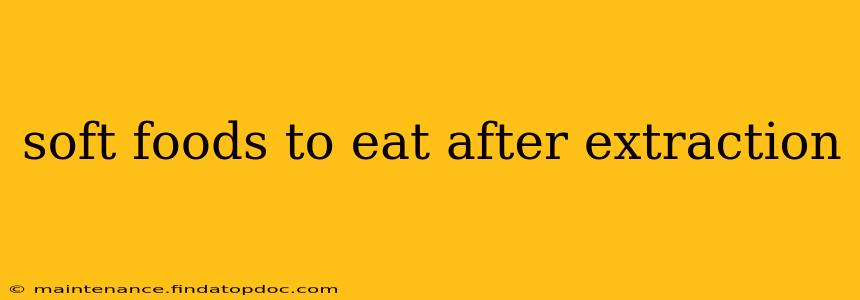Having a tooth extracted can be a bit rough, and knowing what to eat afterward is crucial for a comfortable and speedy recovery. This guide outlines the best soft foods to consume post-extraction, addressing common concerns and ensuring your healing process is as smooth as possible. Remember, always follow your dentist's specific post-operative instructions.
What are the best soft foods to eat after a tooth extraction?
The key is to choose foods that are easy to chew and won't irritate the extraction site. Think creamy, smooth, and easily digestible options. Here are some excellent choices:
- Yogurt: A fantastic source of protein and probiotics, which are beneficial for overall health and gut recovery. Choose plain varieties to avoid added sugars.
- Applesauce: Sweet and simple, applesauce is gentle on the gums and provides essential nutrients. Make sure it's unsweetened or low in sugar.
- Mashed potatoes: A classic comfort food, mashed potatoes are soft, easy to swallow, and packed with carbohydrates for energy.
- Oatmeal: A hearty and nutritious option, especially when made with milk or broth for extra creaminess. Avoid crunchy toppings.
- Scrambled eggs: A protein-rich choice, scrambled eggs offer a gentle texture when prepared correctly.
- Smoothies: Blend fruits, vegetables, and yogurt for a nutritious and easy-to-consume meal replacement. Avoid using straws, as suction can dislodge the blood clot.
- Soups (broth-based): Choose soups with small, tender pieces of vegetables or meat. Avoid chunky soups or those with hard noodles.
- Pudding: A simple and satisfying dessert option, providing a creamy texture and some nutrients.
What foods should I avoid after a tooth extraction?
It's equally important to know which foods to steer clear of:
- Anything crunchy: Chips, nuts, crackers, and popcorn can irritate the extraction site and potentially dislodge the blood clot, leading to complications.
- Anything hard: Avoid hard candies, hard vegetables (like carrots and apples), and tough meats that require significant chewing.
- Anything extremely hot or cold: Extreme temperatures can increase discomfort and potentially damage the healing tissue.
- Straws: Sucking through a straw can create negative pressure, potentially dislodging the blood clot and causing dry socket (alveolar osteitis).
- Spicy foods: Spicy foods can irritate the sensitive extraction site and increase pain.
- Alcohol and Smoking: These significantly hinder the healing process and increase the risk of complications.
How long should I eat soft foods after a tooth extraction?
The duration you'll need to stick to a soft food diet depends on the complexity of the extraction and your individual healing process. Generally, it's recommended to eat soft foods for at least the first few days, and gradually reintroduce other foods as your gums feel more comfortable. Your dentist will provide a more personalized timeframe during your post-operative consultation.
What if I develop dry socket after a tooth extraction?
Dry socket is a painful condition that can occur when the blood clot at the extraction site is dislodged. Symptoms include intense pain, a bad taste in the mouth, and sometimes a visible empty socket. If you suspect you have dry socket, contact your dentist immediately. They can provide appropriate treatment to alleviate the pain and promote healing.
Are there any specific nutritional considerations after a tooth extraction?
Focus on a balanced diet rich in protein, vitamins, and minerals to support healing. Prioritize foods that are easy to consume while providing adequate nutrition.
Can I eat anything with a straw after a tooth extraction?
No, it’s strongly advised to avoid using straws after a tooth extraction. The suction created can dislodge the blood clot, leading to dry socket, a painful complication.
By following these guidelines and paying attention to your body's signals, you can ensure a smoother and more comfortable recovery after your tooth extraction. Remember to always consult your dentist for specific advice tailored to your individual situation.
